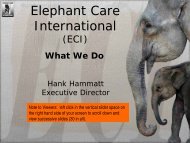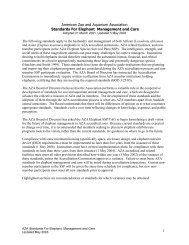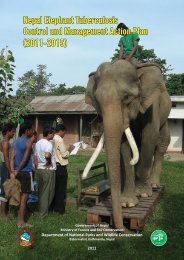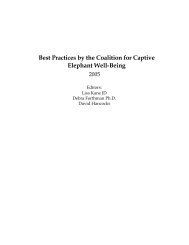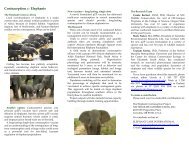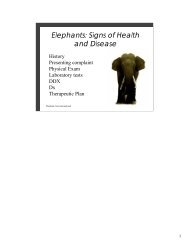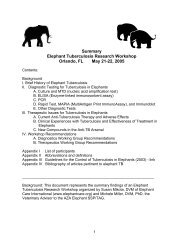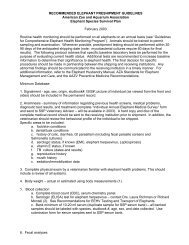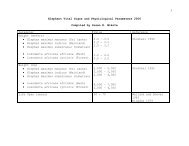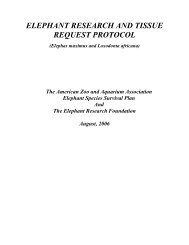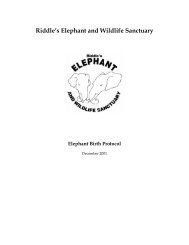Elephants Elephants - Wildpro - Twycross Zoo
Elephants Elephants - Wildpro - Twycross Zoo
Elephants Elephants - Wildpro - Twycross Zoo
- No tags were found...
You also want an ePaper? Increase the reach of your titles
YUMPU automatically turns print PDFs into web optimized ePapers that Google loves.
small family units comprising too many calves of similar ages. It is thoughtthat some of these calves may have joined unrelated females (Nyakaana et al2001). Work on mitochondrial DNA on this population showed that animalsin these groups were derived from different maternal lineages, indicating adisruption of the normal social behaviour. It is also thought that family unitscoalesce as a response to poaching (Eltringham 1982). Culling is routinelycarried out in the Kruger National Park, RSA (van Aarde et al 1999) whereanalysis has shown that once elephant densities reached a certain level thepopulation declines naturally. Thus there is some evidence for naturalbiological control on populations; also data from elsewhere support the theorythat age of sexual maturity i.e. first breading increases with density ofelephants (Dunham 1988).MINIMUM VIABLE POPULATION SIZEHabitat fragmentation, as previously mentioned, is one of the major causes ofthe decline in wild populations and a major threat for the future. Attemptshave therefore been made to assess minimal viable population sizes (MVP). Apopulation and habitat viability analysis (PHVA) was carried out on theelephants of Sumatra in 1993 (Tilson et al 1994). This suggested thatpopulations of less than 25 individuals were at high risk of extinction and apopulation of 40 – 50 animals in secure habitat would have a high chance ofpersistence, with no harvesting (i.e. removal of animals). To sustainharvesting a population of 100 would be necessary. The time frame for thisanalysis was 100 years and it has been suggested that this is too short a timeframe to use for analysis of populations with long generations such aselephant (Armbruster et al 1999) and that a MVP of over 100 animals would bemore realistic. Analysis on size of reserves in Africa was carried out byArmbruster and Lande (1993), which indicated that the minimum was 1,000miles 2 needed to maintain populations for 1,000 years. Using the 100 year timespan Sukumar (1992) arrives at a MVP for elephants in south India at 100 - 200animals allowing for greater poaching of males. Whitehouse and Graham(2002) examined elephants populations in the Addo Elephant National Park(AENP) which had been fenced since 1954 (103 km 2 , in size ) . They found anabove average adult male mortality due to intra-specific fighting, suggestingthat the park was not sufficiently large to accommodate the social needs of themale population.SUSTAINABLE USE OF ELEPHANT POPULATIONSEcologically sustainable socioeconomic activities are those that are bothecologically and socioeconomically sustainable. The southern Africancountries, as previously mentioned, argue for a sustainable controlled trade inelephant products i.e. using elephants at a rate which is within their capacityfor renewal. An example of this is CAMPFIRE (Communal Area ManagementProgramme for Indigenous Resources) in Zimbabwe (Kock 1996). Thisinitiative includes hunting for sport and trophies, and capture and live sales ofanimals. This is carried out within a communal resource management regimewhich guarantees that it is the local communities that benefit from revenue22



